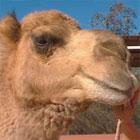Breed: Dromedary Camel (Camelus dromedarius)
Temperament: Headstrong but amenable with training
Cost: $700-$1000 broken in
Lifespan: Up to 40 years in captivity
Maintenance: medium
Recommended for: Outback safaris
History
Camels are not native to Australia. They were first introduced into Australia from Africa, Palestine and India from around 1840 in order to help ‘open up’ the little explored arid inland. Subsequently an estimated 12,000 camels were imported until the early 1900s, when working camels were ultimately released into the wild when road and rail transport became more efficient.
There are two types of camel. The Arabian camel (Camelus dromedaries) has one hump and is called the Dromedary and the Eurasian camel, Camelus bactrianus has two humps and is commonly called the Bactarian camel.
Sir Alec Issigonis, a car engineer who designed the popular Mini once famously said “A camel is a horse designed by committee”. What he meant was that its appearance suggests that its creators couldn’t decide on a consistent formula.
In actual fact, a camel is an animal ideally suited to its environment – the desert.
Appearance
A camel’s hump is basically stored fat, used as an energy reserve during drought conditions. The hump is replenished when food is plentiful and will virtually disappear as it is converted into energy during harder times. A split lip, is used like fingers to strip leaves off trees. The nose has a little crevice that helps to channel moisture down onto the upper lip and large eyes on the side of the head give the camel very good peripheral vision, allowing them to see what threats may be approaching from behind. The long legs allow the animal to stride smoothly and if necessary quickly over the terrain and callus sites on the legs and belly allows the camel to rest comfortably on hot, rocky ground. Their large feet comprise of two toes that are spread over a large surface area, allowing traction on the soft sand.
The coat colour varies from white to almost black with reds and shades of brown (including ‘camel’) in between. The dromedary is around 2m high at the shoulder. Camels are related to alpacas and llamas.
Feeding
Camels are ruminants. Like cows, sheep and goats, they have four stomachs and are able to digest woody cellulose material, enabling them to get the best energy from scarce food supplies.
In captivity they are fed a dry diet of lucerne, oaten and sorghum hay plus mineral licks to supply additional trace elements.
Environmental impact and farming
Amazingly, Australia has the largest feral camel population in the world. With no natural predators and few health and disease problems, the Australian desert has proven to be an ideal environment. This has led to damage of fragile desert environments and waterholes. Camels are capable of eating most of the plant species available in the environment and selectively eat rare plants. Culls and farming for the meat trade are two measures employed to try and limit numbers. The Central Australian Camel Industry Association currently harvests around 5,000-8,000 feral camels from the wild as an alternative meat resource and sells live animals on both the domestic and international markets. Nevertheless the current population is estimated to be between 500,000-700,000.
An unbroken camel fetches around $250-500 per animal. A handled camel from a farm would cost a minimum of $700 up to around $10,000.
Frontier Camel Tours Alice Springs
Frontier Camel Tours offers a range of camel activities for tourists – short camel rides, catered dinners, sunset or sunrise trips or longer rides. There are two depots, one in Alice Springs and another at Ayres Rock Resort.
P.O. Box 2836 Alice Springs N.T. 0871
Phone: +61 8 8953 0444
Fax: +61 8 8955 5015
Toll Free: 1800 806 499
Email Alice Springs: [email protected]
Email Ayers Rock Resort: [email protected]
Further information
Dr. Chris Brown visited Symbio Wildlife Gardens in Stanwell Tops, south of Sydney. Symbio exhibits over 1000 Australian Native, Farmyard and Exotic animals in 16 acres of natural bush and parklands.
Open from 9.30am to 5pm daily (except Christmas Day).
7-11 Lawrence Hargrave Drv Stanwell Tops
Phone: (02) 4294 1244
Email: [email protected]
Web: www.symbiowildlife.com



